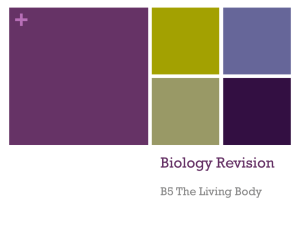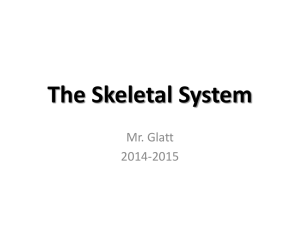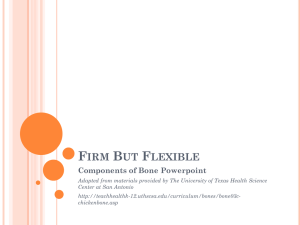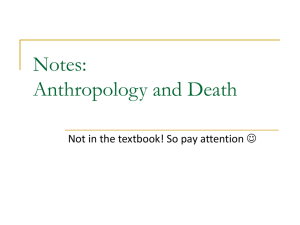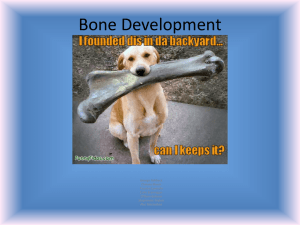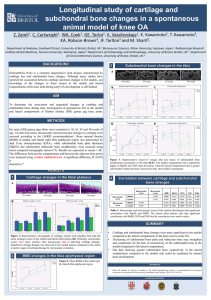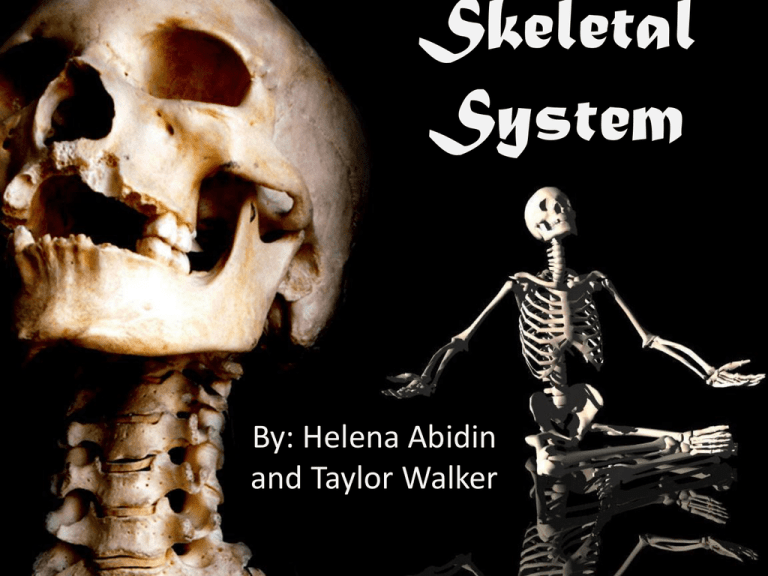
Skeletal
System
By: Helena Abidin
and Taylor Walker
Invertebrate Skeletons
●Framework of bones that supports
and gives form to the body, protects
internal organs, and provides
anchorage points for muscles.
●Each bone is composed of a mineral,
calcium phosphate and protein.
●Bones are joined by ligaments at
places called joints.
●The skeleton itself is composed of
bone and cartilage.
Invertebrate Skeletons
●Skeletons may be internal,
endoskeletons, or external,
exoskeletons.
●Skeletons can also be
hyrostatic. This is when
organisms contract one
part of their body which
results in an extension of
another part
Bone Structure
• There are two classifications
of bones cortical (compact)
and trabecular (spongy)
• Bones are organs composed
of hard living tissue.
• Bones are made of calcium
deposits, protein.
• These minerals (calcium)
make bones rigid, while
proteins (collagen) make
bones strong and elastic.
Bone Structure Continued
• There are 5 main parts of a bone:
marrow, calcified bone,
periosteum, spongy bone, and
cartilage.
• Bone Marrow: soft and crumbly
part of the bone, which is in the
center. There are two types of
marrow, red and yellow.
– The red marrow produces red blood
cells. When you get older, your marrow
turns more yellow due to fat cell
accumulation. The yellow marrow acts
like an emergency reserve in case you
get sick then it will produce blood cells
• Calcified bone: hard but not really
solid bone.
• Spongy bone: is hard with tiny
holes in it.
• Periosteum: is thin but very strong.
-it is the outer membrane, it
helps to rebuild bone cells.
• Cartilage: a strong material that
holds two bones together and
allows them to move over one
another.
Changes in Bone Structure
• The 1st skeleton to form in all
vertebrate embryos is made of
cartilage.
• Then Osteblasts infiltrate the
cartilage model and transform it
into bone, the cartilage in the bone
shaft breaks down and a marrow
cavity is formed.
• In healthy young adults a process
called bone remodeling occurs.
– Bone remodeling: the removal and
deposits that help maintain required
blood levels of calcium and phosphorus
while keeping bones strong
• Osteblasts help form new blood
tissue.
• Until about 24 years old bones
are growing denser and stronger,
later in life this activity declines
and bones gradually weaken.
• Osteoporosis: significant loss in
bone density.
• Deficient calcium or vitamin D
intake, parathyroid problems, and
physical inactivity add to risks.
Declining sex hormone levels in
menopause, smoking, excessive
alcohol intake, and prolonged use of
steroids.
Role of Cartilage
• keeps most bones in place and what
gives shape to soft or fragile spots in
our body
• Strengthens the bones in the body
• Found where flexibility is required
• Functions as a cushion in synovial
joints, where it cushions any impact
between the bones
• Does not contain blood vessels
• Derived from the mesoderm germ
layer
• Osteoarthritis: cartilage covering bone
thins
Interactions with Muscles
• Works together to form “muscuskeletal
system”
• The skeleton is the frame, muscles help
move the frame
• Muscles located on a bone
• Bones and muscles work together
through a series of impulses and signals
communicated between the brain and
skeletal muscles.
• When muscles contract, bones have to
follow
• The movement of a muscle forces the
bone to move with it
have both insertion and origin points
Works cited
• Farabee, M.J(2010 May 18). Muscular and Skeletal Systems. Retrieved from
http://www.emc.maricopa.edu/faculty/farabee/biobk/biobookmusskel.html
• Bridwell, Keith(2010 February 10). Basic Bone Structure. Retrieved from
http://www.spineuniverse.com/anatomy/basic-bone-structure
• Falkner, Sue(2010 February 11). Cartilage and its Role in My Life. Retrieved
from http://www.everydayhealth.com/blog/life-with-chronic-pain/cartilageand-its-role-in-my-life/
• Bone Structure (2010 August 5). Retrieved from
http://library.thinkquest.org/05aug/01257/parts.html.




